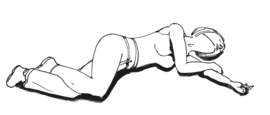Recovery position
The recovery position refers to a position of the body in which an unconscious but breathing person can be placed into as part of first aid treatment in order to prevent death by the suffocation of vomit after a drug overdose. All forms of the recovery position share basic principles. The mouth is downward so that fluid can drain from the person's airway; the chin is well up to keep the epiglottis opened. Arms and legs are locked to stabilize the position of the person.
Many combinations of drugs, especially depressants such as alcohol and GHB, can result in dangerous or even fatal levels of respiratory depression. These substances potentiate the effects caused by one another and can lead to unexpected loss of consciousness at high doses. There is an increased risk of vomiting during unconsciousness and death from the resulting suffocation. If nausea or vomiting occurs, users should attempt to fall asleep in the recovery position or have a friend move them into it.
Technique
One can follow the steps below to move an unconscious person into the recovery position.[1]
- Kneel on the floor at the person's side with them lying on their back
- Place the arm closest to you at a right angle to their body with their hand upwards and towards their head
- Tuck the other hand under the side of their head so that the back of the hand is touching their cheek
- Bend the knee farthest from you to a right angle
- Gently roll the person onto their side by pulling on their bent knee
- In this position, the top arm should be supporting the head with the bottom arm acting to stop you from rolling the person too far
- Next, open the person's airway by gently tilting their head back and lifting the chin
- Check that nothing is blocking their airway and stay with the person to monitor their condition, making sure that they continue breathing and do not go into life-threatening respiratory depression
